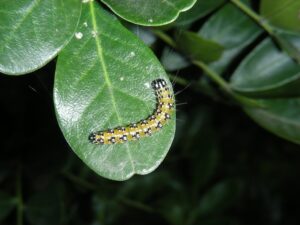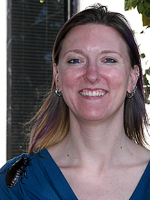 Caterpillars on your Mountain Laurel?
Caterpillars on your Mountain Laurel?
Spring seems to have arrived in Central Texas and my mountain laurels are putting on blooms. If you’re like me and enjoy going in for a good sniff of those grape candy smelling flowers, while you’re there take a look around for caterpillars that may be munching on foliage. Genista caterpillars can be quite common on mountain laurel but may also be found on crape myrtle and honeysuckle.
These caterpillars can grow up to one inch in length and are greenish yellow to orange in color with small black and white dots along their body. They have hairs that emerge along the body but are not densely covered. Genista caterpillars create webbing like that of webworms, but to a lesser degree. Larvae, or caterpillars, feed on leaves within webbing causing defoliation of the plant. Eggs are laid in overlapping clusters on the underside of leaves. Pupation occurs in a small, white silken cocoon that is attached to plants or structures. There are two generations per year.
Management Options
Normally genista caterpillars do not cause significant damage to trees, so no management is required. If you feel management is needed because of a large population, it can be rather simple. If plant size allows, caterpillars can be hand-picked and either smashed or dropped in a bucket of soapy water. Other options may include insecticidal soap, horticultural oils, botanicals, spinosad, or Bacillus thuringiensis var. kurstaki, also known as Bt. Bacillus thuringiensis var. kurstaki specifically targets caterpillars but does not distinguish between “good” and “bad” caterpillars, so be careful where you apply it and be aware of drift that may occur. When using spinosad or Bt, good coverage of plant foliage is essential since the caterpillars need to consume a lethal dose. When using any pesticide product, be sure to read and follow all label instructions.
For more information or help with identification, contact Wizzie Brown, Texas A&M AgriLife Extension Service Program Specialist.
Additional Resources
About Wizzie

Wizzie Brown
County Extension Program Specialist – Integrated Pest Management
Email:EBrown@ag.tamu.edu
Wizzie has been with Texas A&M AgriLife Extension Service since 2002 and has been playing with insects since she was a toddler. She is an Extension Program Specialist with the Integrated Pest Management (IPM) program. Wizzie holds a B.S. in entomology from The Ohio State University and a M.S. in entomology from Texas A&M University. The integrated pest management program provides identification, biological and management information to whomever needs help. Wizzie’s research focuses on imported fire ants, including community wide fire ant management. Wizzie also is happy to provide programs to area groups on a variety of arthropod-related topics. You can find insect and other arthropod information on Wizzie’s blog.
